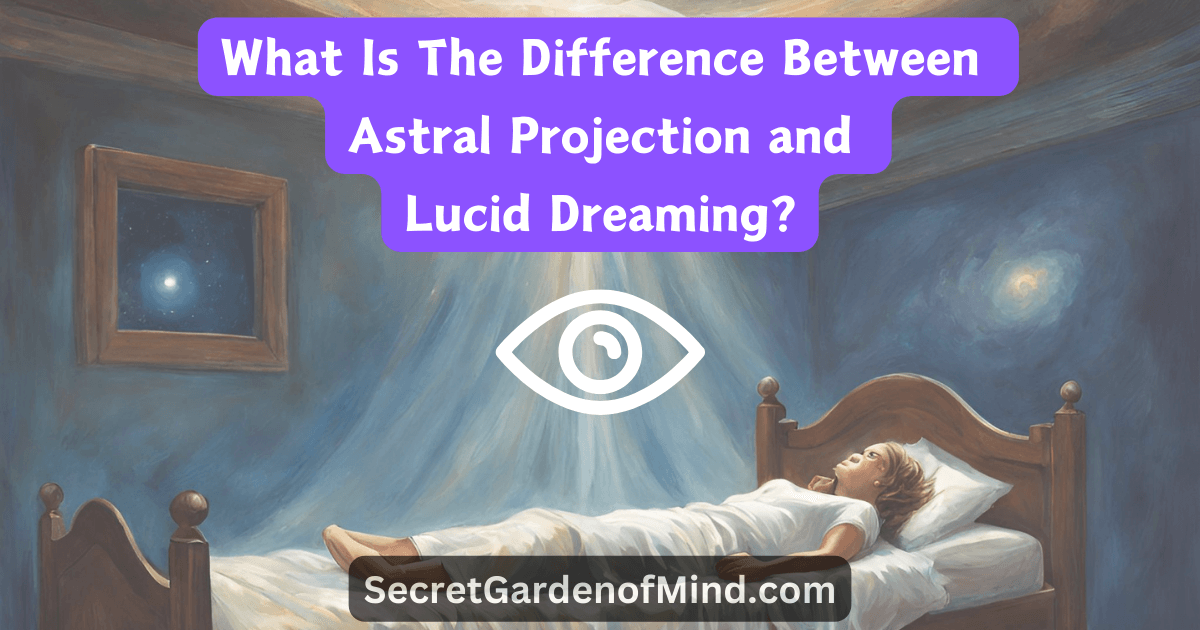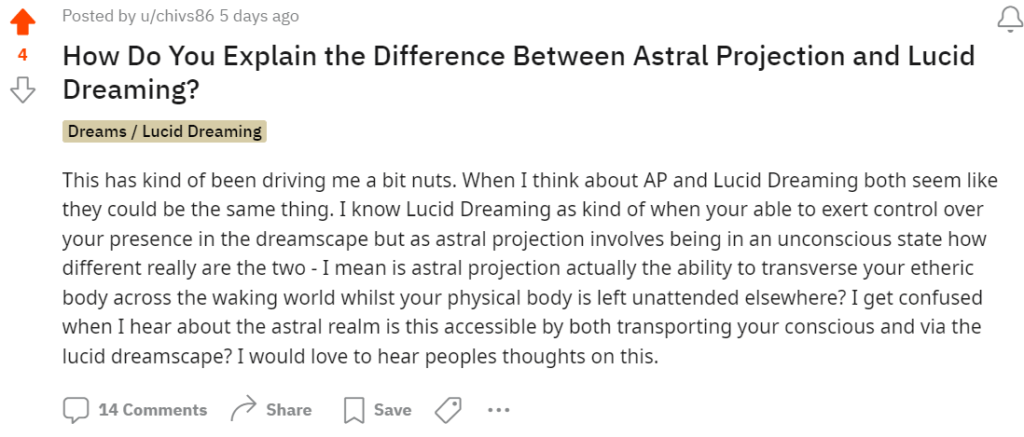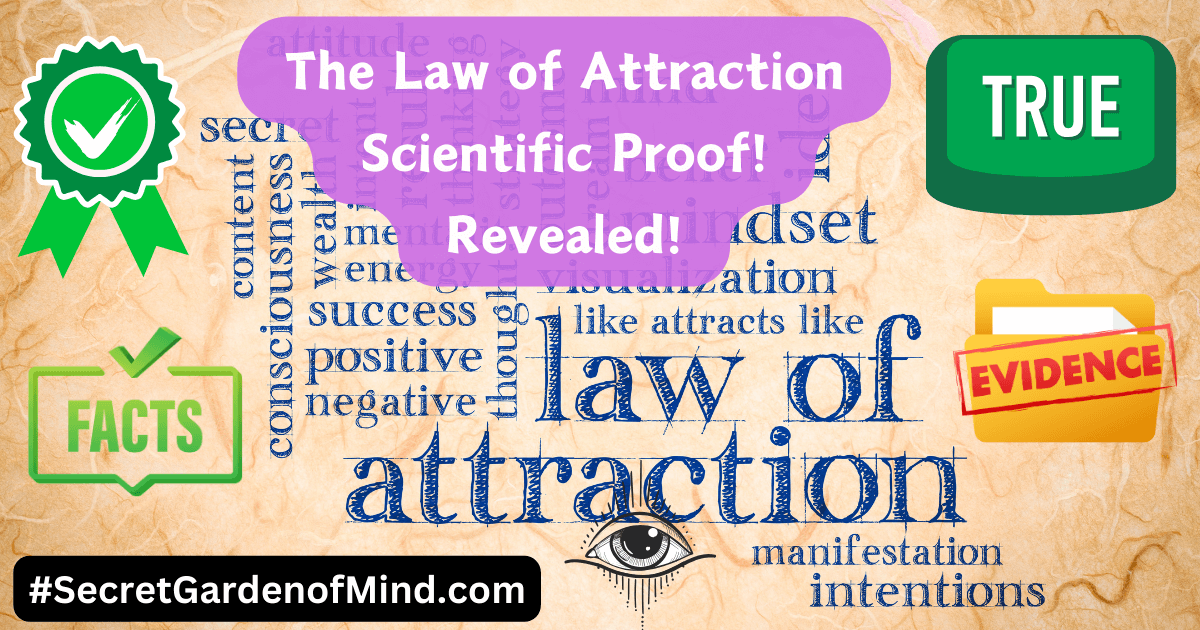What Is The Difference Between Astral Projection and Lucid Dreaming? Reddit Q & A #2

What Is The Difference Between Astral Projection and Lucid Dreaming? These are two fascinating phenomena that quite rightly so have captivated the human imagination for centuries. Both experiences involve a heightened state of consciousness and the ability to explore realms beyond the physical world.
However, while these experiences may seem similar at first glance, it is important to understand the key differences between the two Astral Projection and Lucid Dreaming.
Quite simply put these are NOT the same by nature. There are differences depending on who you ask, and for this purpose I have turned to Reddit’s R/AstralProjection subreddit to find out more.
By understanding the two differences, individuals can have a clearer understanding of which experience they are having and how to navigate their journeys with more clarity going forward.
So, let’s take a look at this.
The Difference Between Astral Projection and Lucid Dreaming?

To begin with I posted on Reddit the following post.

The first answer I got I thought was a good one. I kind of struggled here with this. I wanted to write something like this in the Introduction but I really thought this was better to ask someone else first, and here was my 1st reply.
Lucid dreaming is being aware that you’re dreaming in the moment. You’re also asleep. Lucid dreaming requires sleep.
Astral projection doesn’t require sleep, and involves interaction beyond your own mind. Although you can definitely do it when you’re asleep.
You can also do both at the same time, astral projecting in your sleep while also lucid dreaming, since lucid dreaming is the state of being aware in your sleep (just like you can be aware when you’re awake).
Lucid-Guardian
The next answer was
To Lucid dream is to dream within you with full awareness. Astral Projection is being aware outside your body with full consciousness.
Competitive-Leek-341
So this is an Interesting couple of answers Astral Projection doesn’t require sleep whilst Lucid Dreaming does, and AP is an experience of awareness outside your physical body with full consciousness.
Very good answer I thought. But whilst saying this I like the next one too although I think I will need to reword this to make a bit more sense of it for anyone reading.
For me lucid dreaming makes me feel like I’m stuck, I’m not moving at all. It feels like you’re playing a VR computer game, its cool and all but it doesn’t feel like everything is real. But, AP is when I know I’m not dreaming at all, I can feel the strong wind, I can see my room vividly even with my eyes closed whilst I’m awake. Everything feels like it’s energised. I feel like the true me, the higher me. Hope this helps.
GolfRepresentative62
It does (help). I love Reddit for these Intriguing accounts and there are more too. I’ve personally had many Lucid Dream Experiences over the years and I have wondered if I am experiencing astral projection sometimes and this is quite Interesting – according to some you can piggyback off a Lucid Dream to enter the Astral plane.
Like In this answer here…
In Lucid Dreams, you are aware but still you are only present in your dream landscape that your mind has created. Your mind is awake but your environment is not real.
When you are Astrally Projecting you aren’t in a dream landscape anymore.
When I AP I start by becoming lucid but then let myself fall out of the dream. At that point I am not dreaming anymore, I am in the Astral. It feels very, very different to me then dreaming because the Astral is real.
Different from the physical but unlike dreams, real.
MirVie
Understanding Astral Projection: Definition and Process
Astral Projection, also known as out-of-body experience (OBE), is the phenomenon where an individual’s consciousness separates from their physical body and travels outside the physical form and to different dimensions or planes of existence.
During Astral Projection, individuals may feel a sense of floating or flying, and they can explore different realms, interact with other entities, and gain knowledge and insights beyond the physical realm.
The process of Astral Projection typically involves deep relaxation, meditation, and visualization techniques. By quieting the mind and entering a state of deep relaxation, individuals can detach their consciousness from their physical body and enter the astral plane.
The level of control and clarity can vary from person to person, and this is something that can develop over time.
Common experiences during Astral Projection include a sense of weightlessness, heightened senses, meeting other entities or beings, visiting different locations or dimensions, and gaining spiritual insights or knowledge.
Some individuals may also experience vibrations or buzzing sensations as they separate from their physical body.
It is different for different people. I shall Include a couple more answers below.
I always considered Lucid Dreaming to be body & mind asleep, whereas Astral Projection I’ve always thought is body asleep mind awake, though of course I could be wrong!
ExodusOfSound
Explain the difference between the waking world and lucid dreaming, now look at lucid dreams and astral projection the same way, there is your answer.
Renovicesss
It really does come down to a matter of perspective I think and here is a really good answer.
Unfortunately people who talk about ‘dreaming’ being different from AP often imply the mind is limited to the brain in such states. But really this is just an an assumption and doesn’t help because the evidence suggests memory may not be entirely physical in the body, just linked there.
The main difference seems to be by convention (similar experiences) or beliefs about what’s happening/evidence. You have to remember Astral projection was conceived through Theosophy when Ether was a deep scientific question and Quantum Mechanics was not established.
We now see at deep levels of reality (QM) time and space do not behave like they do in the 3d world*, and some even speculate reality is really a holographic projection. Astral Projection was also heavily inspired by other esoteric traditions such as the ancient Egyptian and Merkabah schools.
*this seems to be at odds with some ideas of projection though Projection probably best means something like ‘unfolding’ or revealing in the context of AP, with Astral meaning light.
ie. revealing the light
(and that’s it really)
Wise_Milk2519
Understanding Lucid Dreaming By Definition

Lucid Dreaming is the phenomenon where individuals become aware that they are dreaming while they are still in the dream state. Unlike Astral Projection, Lucid Dreaming occurs within the realm of dreams and does NOT (apparently) involve the separation of consciousness from the physical body.
In a Lucid Dream, individuals have the ability to control their actions, manipulate the dream environment, and interact with dream characters. The process of Lucid Dreaming involves becoming aware of the dream state while still in the dream.
This can be achieved through reality checks, such as looking at a clock or trying to read a text, as these actions often appear distorted or nonsensical in dreams. By regularly practicing reality checks and developing a habit of questioning reality, individuals can increase their chances of having Lucid Dreams.
Common experiences during lucid dreaming include the ability to fly, manipulate the dream environment, meet deceased loved ones or historical figures, and explore fantastical landscapes.
Lucid Dreams can be incredibly vivid and lifelike, often indistinguishable from waking reality. However, it is important to note that the level of control and clarity can vary from dream to dream and from individual to individual. And on this note here is another very good answer I got from my Reddit post.
If you do the research, you can find plenty of brain scans showing that Lucid Dreaming and Astral Projection are both very different processes. Dreaming and lucid dreaming differences are very clear in brain scans.
We can also trigger out of body experiences by zapping the brain with electrodes. I don’t think anyone has been able to trigger a Lucid Dream with an electrode.
There are likely many confusing reports, where the people experiencing these don’t know the difference, or where these phenomena blend. There are likely many reports of this that are nothing but dreams or mental illness problems. All of these exist, and they are all different in the brain scans.
But, without the scans, people are guessing and making assumptions.
I like the version where the woman was tested in the lab and Astral Projection was the ability to see targets outside of any possible regular vision. So she had an actual viewing function away from the physical body. This sounds like a solid thing we could use as a description for Astral Projection, projection is then outside the body, and observing reality in real time.
Although, this then blends with Remote Viewing. Are Remote Viewing and Astral Projection simply the same thing from a different mindset, one relaxed and semi- or totally unconscious, one while you are awake?
Lucid Dreaming is simply control over the dreamscape with frontal lobe decision making control, but it is still dreaming, and dreams are in your head.
Lucid Dreams are not supplying real information about the environment.
Still, People who claim to go to Astral Planes, have no proof of anything. It is NOT exactly a shared space where people can compare notes and in this sense they could be Lucid Dreaming this. So this would be where the descriptions cross over and blend.
Using the science can help draw a clear and distinct difference between real and imaginary experiences.
My desire to keep these experiences separated is obviously just my own, and the public and science will continue to mix them up and combine them with mental illness and deranged nonsense. So I lose.
I can see they are distinctly different, brain scans show they are distinctly different, so public opinion and faulty belief systems are then the issue.
whatawierdlife
I like this answer some good points but it is from this viewpoints that the lines become blurry.
Yet, the next response claims to give this question a bit more clarity.
The only difference between those experiences is YOU. How aware you are.
Read this: https://www.reddit.com/r/AstralAcademy/s/6RY1Tb2H5Y
Xanth1879
Apparently, it’s all a matter of awareness.
Key Differences Between Astral Projection and Lucid Dreaming – Telling the Two Apart!

While Astral Projection and Lucid Dreaming share some similarities, there are key differences that distinguish the two experiences. As much as there is not really much as a tangible explanation for what is really happening during these experiences still based on first-hand accounts there are reasons these don’t have the same name.
These include;
1. Nature of Experience: Astral projection involves the separation of consciousness from the physical body and the exploration of different dimensions or planes of existence. It is often described as a more “real” or “out-of-body” experience. Whilst, on the other hand, Lucid Dreaming occurs within the realm of dreams and (they say this) is a product of the individual’s imagination.
*Note: I would theorize there could be more happening than just made up stuff in someones mind. The same with any kind of dreaming but as some claim Astral Projection can occur within our own physical plane. Remote Viewing is possible proof of this and these two may actually be the same thing.
2. Level of Control: In astral projection, individuals may have limited control over their experiences and interactions in the astral plane. They may encounter other entities or beings and have little control over the environment or events that unfold. In contrast, lucid dreaming offers a higher level of control, allowing individuals to manipulate the dream environment, interact with dream characters, and even change the course of the dream.
3. Perception of Reality: During astral projection, individuals often have a heightened sense of reality and perceive their experiences as more “real” than everyday waking life. They may encounter entities or beings that feel distinct and separate from their own consciousness. In lucid dreaming, individuals are aware that they are in a dream state and may have a more fluid perception of reality, knowing that the dream is a product of their own mind.
Note: Some claim to encounter independant entities within Lucid Dreams. It is certainly a hard concept to grasp but if this were the case this would likely by due to these entities astrally projecting themselves into your dreamscape.
4. Physical Sensations: Astral projection can involve physical sensations such as vibrations, buzzing, or a feeling of floating or flying. These sensations are often felt during the separation of consciousness from the physical body. In Lucid Dreaming, physical sensations are less common, as the experience is primarily within the realm of the mind.
Astral Projection vs. Lucid Dreaming: Which One is More Real?
The question of whether Astral Projection or Lucid Dreaming is more real is a subject of debate among practitioners and researchers. While both experiences involve altered states of consciousness and can feel incredibly vivid and lifelike, the nature of reality experienced in each is different.
From a scientific perspective, both astral projection and lucid dreaming are considered subjective experiences that occur within the individual’s mind. They are often attributed to the activation of certain brain regions and the release of neurotransmitters associated with dreaming and altered states of consciousness.
However, there are anecdotal accounts and personal experiences that suggest the possibility of Astral Projection involving the exploration of both our own and realms beyond the physical world.
Some individuals claim to have encountered entities or beings that feel distinct and separate from their own consciousness, leading to the belief that astral projection offers a glimpse into other dimensions or planes of existence. Although, again it really depends who you ask.
Personally I don’t think there is a difference, other than the way the experience begins – but it’s against the rules to say that on here 😉
The Role of Consciousness in AP and Lucid Dreaming

Consciousness plays a crucial role in both astral projection and lucid dreaming. It is the awareness and self-reflective aspect of our being that allows us to experience these altered states of consciousness.
In Astral Projection, consciousness separates from the physical body and enters the astral plane. The level of consciousness and awareness during astral projection can vary, with some individuals experiencing a heightened sense of self and others feeling more detached or dissociated from their physical body.
In Lucid Dreaming, consciousness becomes aware that it is in a dream state. This self-awareness allows individuals to have control over their actions and interactions within the dream. By enhancing consciousness during lucid dreaming, individuals can have more vivid and memorable experiences.
There are various techniques and practices that can enhance consciousness for better experiences in both Astral Projection and Lucid Dreaming. These include meditation, mindfulness, visualization, and self-reflection.
By cultivating a deeper sense of self-awareness and presence, individuals can have more profound and transformative experiences in these altered states of consciousness.
The main difference is that lucid dreaming requires the dreamer to be sleeping. Astral projection is different and can happen at literally any time, anywhere. Sometimes unexpectedly.
Astral projection can happen while the brain is 100% awake and still buzzing with activity.
Lucid Dreaming pretty much always happens while the brain is in REM and is a much lower state in terms of awareness/lucidity than astral projection is.
Glad-Pollution-1928
Techniques for Achieving Astral Projection and Lucid Dreaming
There are various techniques and practices that can help individuals achieve Astral Projection and Lucid Dreaming. These techniques involve a combination of mental, physical, and spiritual practices. Really these exercises can be good for either.
Lucid Dreaming is probably the easier of the two (speaking from my own experience) but anyway there certainly is a relationship between the two. Some exercises you can try to train yourself for both include;
1. Meditation and Visualization: Regular meditation and visualization practices can help individuals enter a relaxed and focused state of mind, which is conducive to astral projection and lucid dreaming. By quieting the mind and visualizing desired outcomes, individuals can enhance their ability to enter altered states of consciousness.
2. Reality Checks and Affirmations: Reality checks involve questioning one’s reality throughout the day to increase self-awareness and enhance the chances of having a lucid dream. This can include looking at a clock or text and checking if they appear distorted or nonsensical.
Affirmations can also be used to program the subconscious mind for astral projection or lucid dreaming, such as repeating statements like “I am aware in my dreams” or “I can astral project with ease.”
3. Good Sleep Hygiene: Practicing good sleep hygiene is essential for achieving Astral Projection and Lucid Dreaming. This includes maintaining a regular sleep schedule, creating a comfortable sleep environment, and avoiding stimulants or heavy meals before bedtime.
Keeping a dream journal can also help individuals remember their dreams and increase their chances of having lucid dreams.
Note: I recently published a post about one of own dream experiences. Read My Dream Diaries HERE<<
Conclusion: Choosing Between AP and Lucid Dreaming
In conclusion, both astral projection and lucid dreaming offer unique and transformative experiences for individuals who are interested in exploring altered states of consciousness. While they share some similarities, it is important to understand the key differences between the two experiences.
Choosing between astral projection and lucid dreaming ultimately depends on personal preferences and goals. Some individuals may be more drawn to the spiritual and out-of-body nature of astral projection, while others may prefer the creative and immersive aspects of lucid dreaming.
It is also important to prioritize safety and responsibility when engaging in these practices, as they can have profound effects on one’s well-being.
Ultimately, individuals are encouraged to explore both astral projection and lucid dreaming, as they offer unique opportunities for self-discovery, personal growth, and spiritual exploration.
By understanding the differences between the two experiences and practicing them with intention and mindfulness, individuals can embark on transformative journeys of consciousness.



amazon bean products bean products accent pillows bean products bean bags bean products bed pillows bean products bolster bean products chicago bean products coupon code bean products decorative accent pillows bean products shredded foam bean products usa bean products yoga bean products zafu benefits of meditation for adhd best type of meditation for adhd buddhist meditation for adhd Dream Diaries Dream Master energy healing Entrainment machine how to lucid dream Law of Attraction Laxman innertainment Light and Sound Machine Light and Sound Meditation Mind Machine lucid dream herbs Manifestation meditation meditation alzheimer meditation alzheimer prevention meditation alzheimers meditation classes adhd meditation cure adhd meditation dementia meditation for adhd adults meditation for adults with adhd Meditation for healing sports injuries meditation for memory loss meditation memory meditation memory loss Mindplace Procyon mr bean new products remote viewing amplifier remote viewing baby monitor remote viewing books pdf remote viewing experiments





